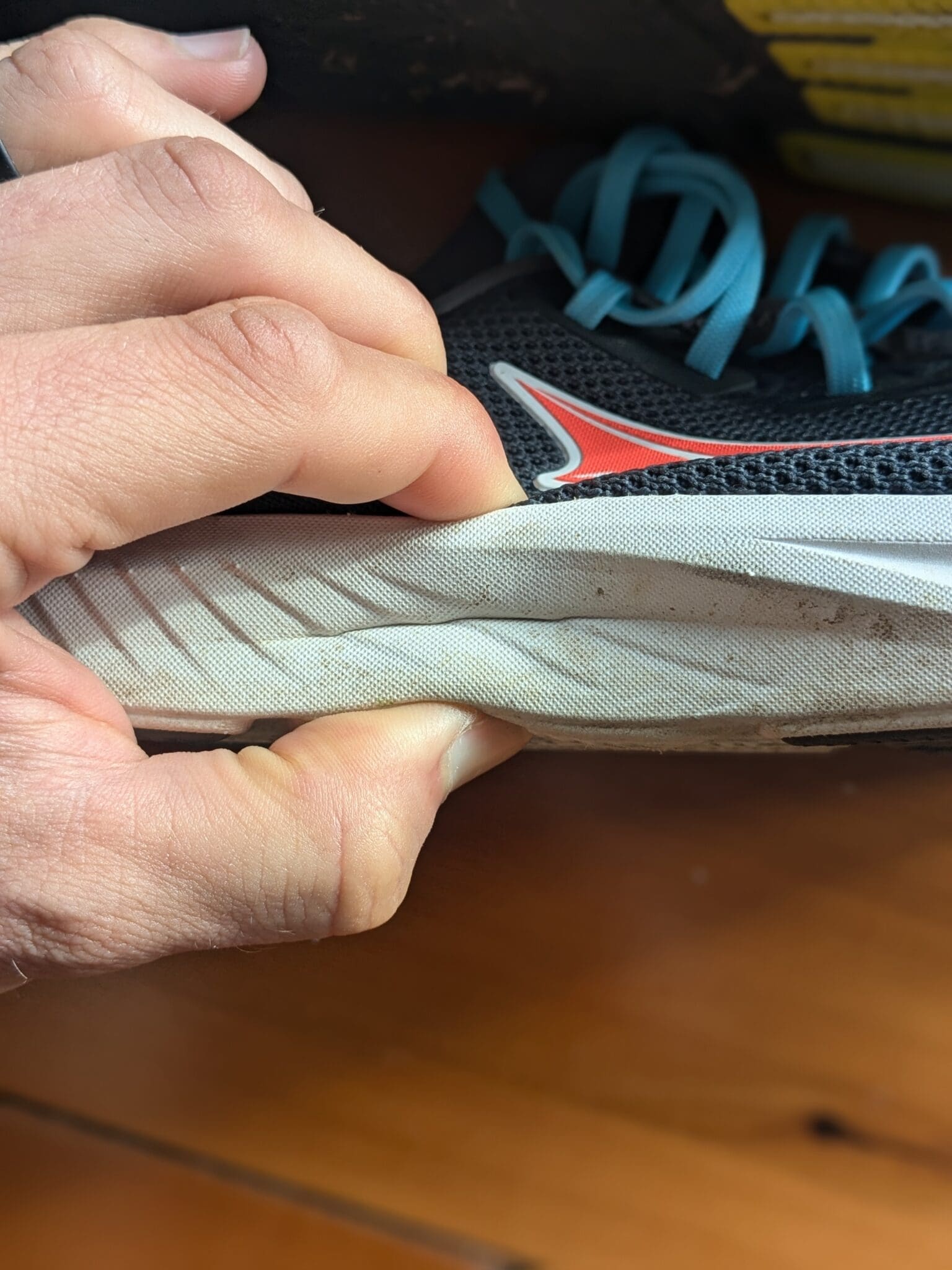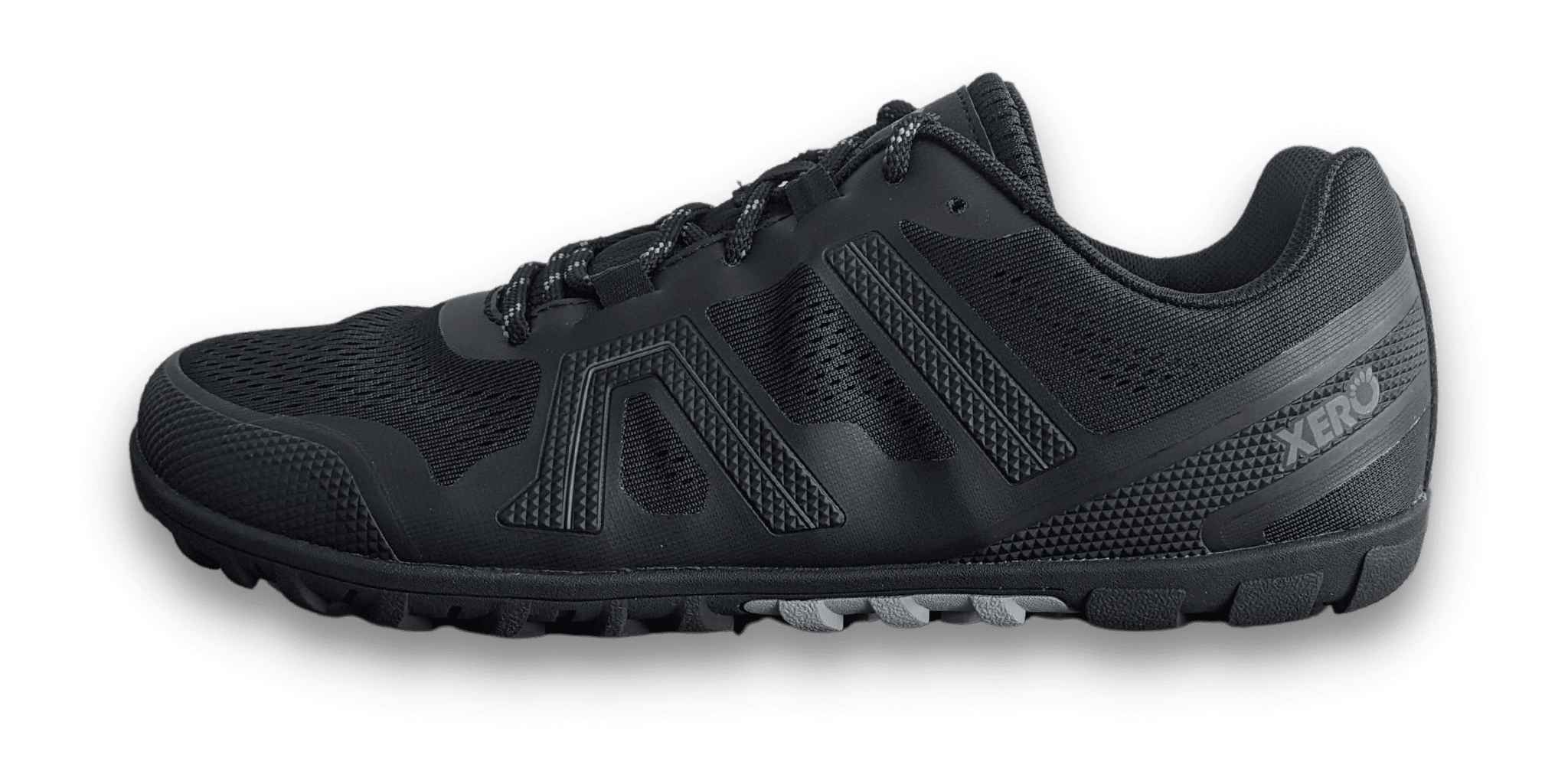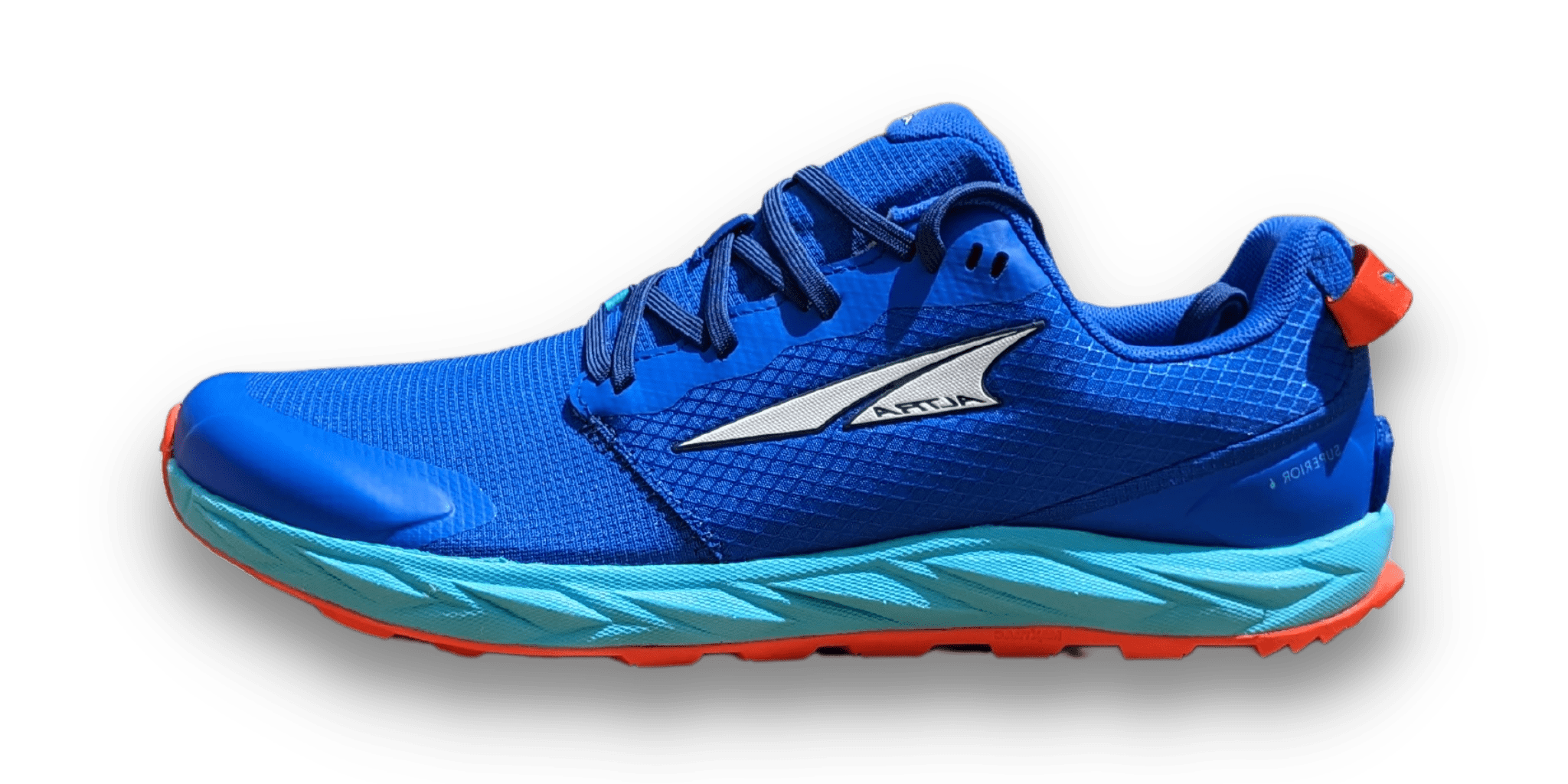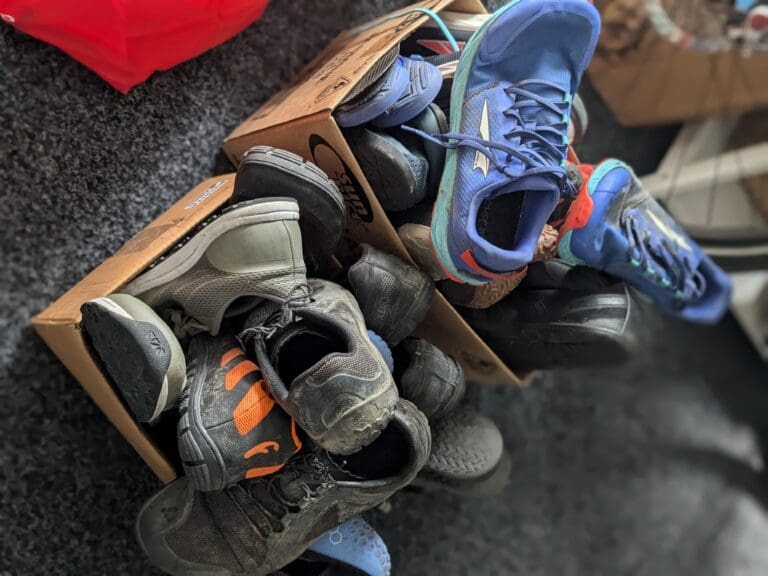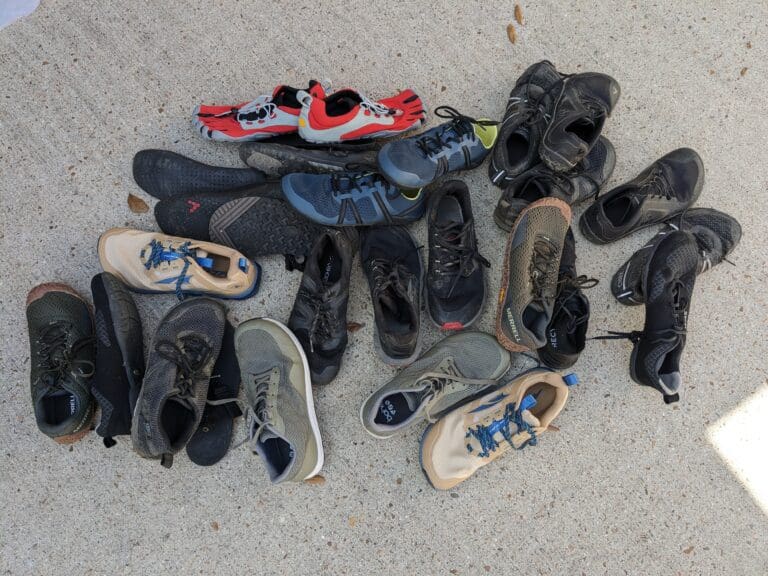We’ve all heard the warnings. “You can’t run on trails in minimal shoes. What if you step on a sharp rock?”.
Well, it’s true that landing with all your force on a sharp rock with minimal cushion (or none) is going to hurt. But if you land “mindfully” and softly, it’s not all that bad!
With that said, when you get further into a run, your brain and body naturally start to fail, and you become more sloppy with your foot placement. Pair this with minimal shoes, yes, and it may lead to painful landings and injury.
And that’s where cushion comes in.
Yes, I said it! Cushioning has a place in some running shoe rotations. It’s a tool we can use depending on the goal of our run. And in this case, we’re trying not to get injured!
But how much cushion is “enough,” and when does that stack height become detrimental?
I’ll answer that in this post. So, if you’re a minimal runner considering some protection, keep reading. Or if you’re an Altra runner wondering if you could run in minimal shoes on the trail, you’ll find some handy tips, too!
Affiliate Disclosure: By clicking through the links on this page and purchasing the products, you’ll be helping me out. This is done because I receive a kickback from the sellers at no extra cost to you! Thank you so much for supporting us!
Small amounts of shoe cushioning can be a game-changer when running on rocky, uneven terrain. But recently, we’ve seen a trend in the running shoe industry where more cushion equals better, which is plainly not true, especially on the trail.
Which minimal running shoe is for you?
Take a quick 5-question quiz to identify the perfect minimal running shoe for your feet! You'll get both road and trail options based on your answers!
Because trails are naturally uneven, we’re forced to stabilize the forces exerted on our bodies. This puts more stress on the feet, ankles, and the whole body!
An important part of these stabilization systems is the feedback gained through ground feel. Being close to the ground and even “feeling” the ground can give your sensory system a ton of information to stabilize the body properly. As we remove our feet from the ground, i.e., with cushioning, that feedback loop breaks down, and we risk injuries or inefficiencies.
Case and point: Have you ever turned your ankle on the trail? It’s less likely to happen in minimal shoes.
Now that we know being close to the ground can improve sensory feedback, the logical solution is to run barefoot, right?
Not too fast! There’s another point to consider.
And that’s sharp pokey rocks and vegetation.
Some of those rocks can be sharp enough to cause real damage! If you’re extremely careful, you can hit the trail barefoot, but at that point, you’re likely moving so slowly that it’s hard to call it a run.
Trust me, I’ve learned the hard way. One day, I headed on the trails with 3-4mm sandals, and my heels were bruised for months. It’s not fun!
So what’s the solution?
You guessed right! A little cushion. And a little cushion goes a long way!
Adding a few millimeters of cushion can take the edge off those rocks. Even thin, flexible rock plates can make a difference without sacrificing too much ground feel.
That’s why shoes like the Xero Shoes Scambler Low, which I wouldn’t consider very minimal, have their place on tougher and rugged terrain.
And trails can be soft
Not all trails are rocky. Some are sandy and soft or even sloppy with mud.
When hitting trail conditions like this, protection is less of a concern, and you can opt for more barefoot-style options. Just ensure those barefoot options still have substantial lugs to grip in the sloppy conditions. Also, remember to ensure a great fit; you don’t want to lose a shoe in the deep mud!
Now you know that choosing the right shoe for trail running is about balancing ground feel and protection, so let’s look at some examples.
Xero Shoes Mesa Trail II
Xero Shoes Mesa Trail II
Width: Average
Stack height: 6mm + 3.5mm insole
Weight: 8.2oz / 232g
I love the Mesa Trail’s; the ground feel is sublime for a closed-toe trail shoe. The upper is flexible enough to wrap around the foot like a glove, and as long as you don’t have a huge toe splay, the width in the toe box is good enough.
But if you’re doing a 50km race on rocky, steep ground, think again.
Agina, I speak from from experience.
The Andorra 50km course has some super rocky parts, and with 3800m of ascent, and it was steep. While I still made it around, my feet were not happy with my shoe choice. After kicking a bunch of rocks, bruising my toes, and stepping on one too many sharp edges, I wished for the Altra Superior.
I still use the Mesa Trails ALOT, but now I’m more selective, depending on the terrain I’m running on.
Vivobarefoot Primus Trail
Vivobarefoot Primus Trail FG
Width: Average
Stack height: 2.5 mm + 4 mm lugs + 3mm insole
Weight: 8.9 oz / 250 g
Vivobarefoot shoes may not fit everyone, but if you have a shallow, more narrow foot, you can’t go wrong with the Primus range.
The stack height is low, at 5.5mm, but it feels more protective than the numbers suggest.
Recently, I ran a 65km course that was relatively unknown to me. Because I didn’t want a repeat of the Andorra 50km, I decided to play it safe and use the Primus Trail to ensure protection while maintaining a minimal feel.
Despite the wild and varied conditions, I came away from the race with zero foot problems.
Altra Superior
Altra Superior 6
Width: Narrow-midfoot Wide toebox
Stack height: 21mm
Weight: 9.5 oz / 270 g
The Superior used to be my go-to for almost any trail run.
The soft cushion protected me from obstacles on the trail, and the flexibility gave me a feeling of minimalism.
While the new model is not quite as soft as it used to be, and the shallow fit is odd, they remain an option in my rotation when I need an easy day on the trails.
They are a great option for those not well versed in barefoot running but want to gain more ground feel.
Freet Calver
$110
Use code BBR10 for 10% off any models
Freet Calver
Width: Wide
Stack height: 3.5 mm + 6 mm lugs + 3mm insole
Weight: 9.87 oz / 280 g
Review Coming soon
Freet is relatively new to me, but they already fill a huge gap in my rotation.
Simply put, if I need grip, the Freet Calver is the choice.
With 6mm lugs, these stick to the ground no matter how muddy.
You may think that 6mm lugs would lead to less ground feel. Well, that’s somewhat true, but the connective rubber making up the rest of the outsole amounts to 3.5mm, meaning the shoe is still super flexible, making it feel very minimal.
It should be said the fit of Freet shoes are very wide and deep. I know that’s what many in the barefoot scene are looking for, and if that’s you, TRY THEM! But if you have a narrow, shallow foot, you’re probably best trying one of the options above.
Finding the right trail shoe is all about balance.
Balance in the fit: Roomy enough for foot mobility but tight enough to reduce movement inside the shoe
Balance in the feel: Protective enough to dampen sharp objects but minimal enough to provide good ground feedback.
Achieving this balance depends on your unique foot shape and the specific conditions you’ll be running in.
The reality is there’s no such thing as a “perfect” shoe. Instead, you’re searching for the least–worst option for your next run. And that shoe is likely already in your rotation. :p
